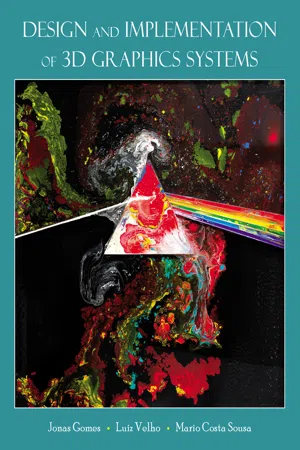
eBook - PDF
Design and Implementation of 3D Graphics Systems
- 350 pages
- English
- PDF
- Available on iOS & Android
eBook - PDF
Design and Implementation of 3D Graphics Systems
About this book
Design and Implementation of 3D Graphics Systems covers the computational aspects of geometric modeling and rendering 3D scenes. Special emphasis is given to the architectural aspects of interactive graphics, geometric modeling, rendering techniques, the graphics pipeline, and the architecture of 3D graphics systems. The text describes basic 3D com
Frequently asked questions
Yes, you can cancel anytime from the Subscription tab in your account settings on the Perlego website. Your subscription will stay active until the end of your current billing period. Learn how to cancel your subscription.
At the moment all of our mobile-responsive ePub books are available to download via the app. Most of our PDFs are also available to download and we're working on making the final remaining ones downloadable now. Learn more here.
Perlego offers two plans: Essential and Complete
- Essential is ideal for learners and professionals who enjoy exploring a wide range of subjects. Access the Essential Library with 800,000+ trusted titles and best-sellers across business, personal growth, and the humanities. Includes unlimited reading time and Standard Read Aloud voice.
- Complete: Perfect for advanced learners and researchers needing full, unrestricted access. Unlock 1.4M+ books across hundreds of subjects, including academic and specialized titles. The Complete Plan also includes advanced features like Premium Read Aloud and Research Assistant.
We are an online textbook subscription service, where you can get access to an entire online library for less than the price of a single book per month. With over 1 million books across 1000+ topics, we’ve got you covered! Learn more here.
Look out for the read-aloud symbol on your next book to see if you can listen to it. The read-aloud tool reads text aloud for you, highlighting the text as it is being read. You can pause it, speed it up and slow it down. Learn more here.
Yes! You can use the Perlego app on both iOS or Android devices to read anytime, anywhere — even offline. Perfect for commutes or when you’re on the go.
Please note we cannot support devices running on iOS 13 and Android 7 or earlier. Learn more about using the app.
Please note we cannot support devices running on iOS 13 and Android 7 or earlier. Learn more about using the app.
Yes, you can access Design and Implementation of 3D Graphics Systems by Jonas de Miranda Gomes,Luiz Velho,Mario Costa Sousa in PDF and/or ePUB format, as well as other popular books in Computer Science & Computer Graphics. We have over one million books available in our catalogue for you to explore.
Information

1
Introduction
This
book
covers
practical
aspects
of
computer
graphics
at
an
introductory
level.
The
material
presented
focuses
primarily
on
the
fundamental
algorithms
of
the
area,
the
im-
plementation
problems
associated
with
them,
and
the
relationship
between
the
various
components
of
a
graphics
system.
1.1
Computer
Graphics
Computer
graphics
is
the
study
of
computational
processes
involving
geometric
models
and
digital
images
.
The
relations
between
data
and
processes
in
computer
graphics
are
illus-
trated
in
Figure
1.1.
From
a
computational
point
of
view,
we
have
two
distinct
types
of
data
:
models
and
images.
The
processes
that
can
be
applied
to
these
data
either
modify
a
single
tyep
of
data
or
convert
the
data
from
one
type
into
another:
Creating
or
modifying
models
is
done
by
geometric
modeling
;
manipulating
images
is
called
image
processing
.
Image
synthesis
,
used
in
the
field
of
computer
vision,
is
the
transformation
of
geometric
models
into
digital
images.
Model
Image
Geometric
Modeling
Image
Processing
Computer
Vision
Image
Synthesis
Figure
1.1.
Data
and
processes
in
computer
graphics.
1
Table of contents
- Front Cover
- Dedication
- Contents
- About the Cover
- Preface
- 1. Introduction
- 2. Objects and Graphics Devices
- 3. Interaction and Graphical Interfaces
- 4. Geometry
- 5. Color
- 6. Digital Image
- 7. Description of 3D Scenes
- 8. 3D Geometric Models
- 9. Modeling Techniques
- 10. Hierarchies and Articulated Objects
- 11. Viewing and Camera Transformations
- 12. Surface Clipping for Viewing
- 13. Rasterization
- 14. Visible Surface Calculation
- 15. Local Illumination Models
- 16. Global Illumination
- 17. Mapping Techniques
- 18. Shading
- 19. 3D Graphics Systems
- Bibliography